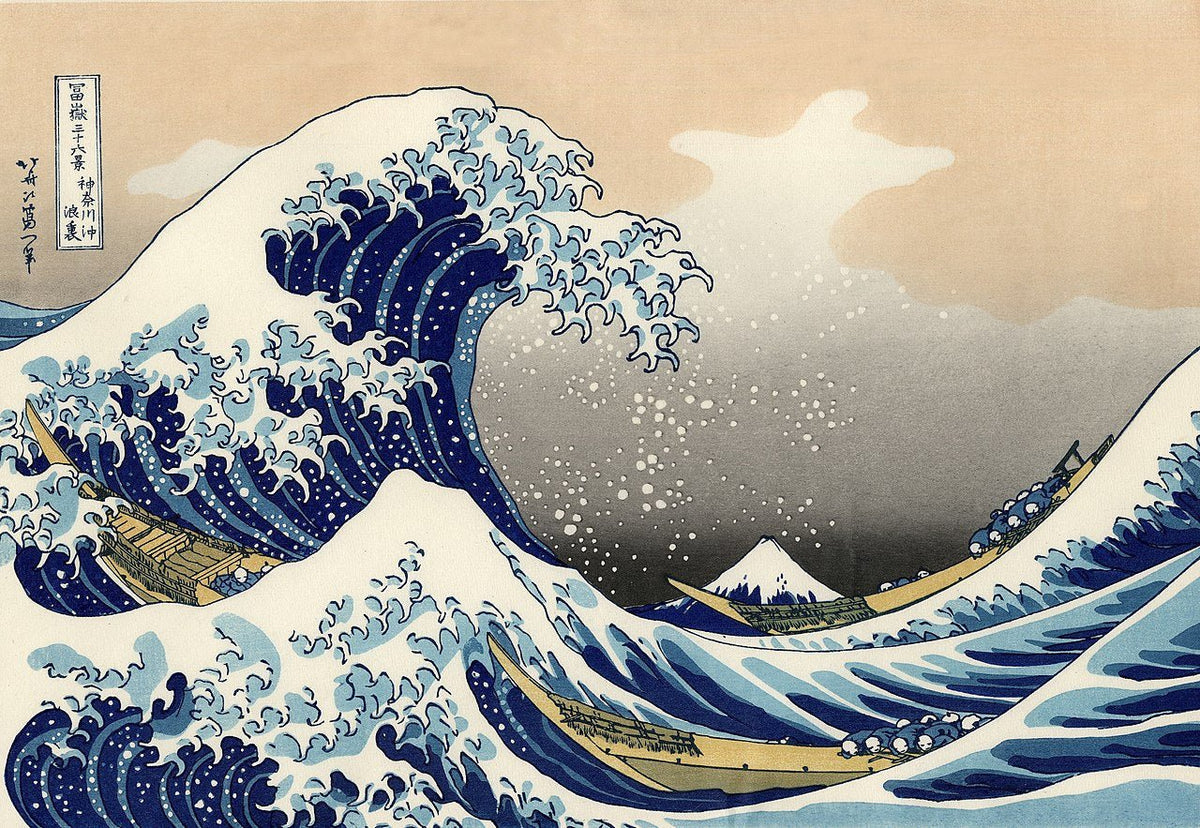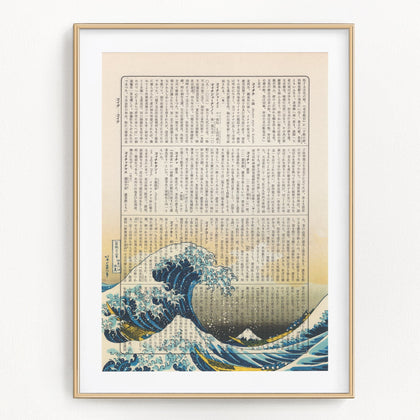
Ukiyo-e: The Floating World of Japanese Art Prints and Its Symbolism
|
|
Time to read 5 min
The Essence of the Japanese "Floating World" in Ukiyo-e prints
Ukiyo-e, directly translating to "pictures of the floating world," embodies the concept of "ukiyo," a term originally rooted in Buddhist philosophy. Historically, "ukiyo" described the suffering of life, but over time, its connotation shifted in the Edo period to symbolize the transient, fleeting nature of worldly pleasures and desires. These Japanese prints of a "floating world" represented a hedonistic urban lifestyle, marked by entertainment, leisure, and ephemeral beauty, particularly in the pleasure districts of cities like Edo (modern-day Tokyo). In essence, ukiyo-e captures this evanescent world in vibrant visuals.
Symbolism in Japanese Ukiyo-e prints
Nature and Seasons
Japanese prints, in their exquisite detail and vivid imagery, have long been a testament to the nation's profound connection to the natural world. This affinity for nature is deeply rooted in Japan's cultural and spiritual fabric, a reflection of centuries-old traditions and beliefs. Within these prints, elements like cherry blossoms stand out not just for their aesthetic appeal but for their symbolic weight. These delicate flowers, in their transient bloom, encapsulate the fleeting and cyclical nature of life, serving as a poignant reminder of its impermanence. In stark contrast, the majestic Mt. Fuji, often depicted with an air of reverence and awe, symbolizes enduring strength and permanence. Artists like Hokusai have immortalized this iconic mountain in their works, capturing its unchanging presence amidst the ever-evolving landscapes. Through such portrayals, Japanese prints convey a dual message: a celebration of the transient beauty that surrounds us and a deep respect for the eternal forces that anchor our existence.

Beautiful Women (Bijin-ga)
Japanese art prints, particularly those featuring women such as courtesans and geishas, offer a complex and multifaceted portrayal of femininity. Beyond their undeniable aesthetic allure, these prints carry profound undertones that transcend mere visual representation. The delicate and ephemeral beauty of these women, as captured in the intricate details and nuanced expressions, serves as a poignant reminder of the transient nature of beauty, an aspect deeply ingrained in Japanese culture and aesthetics. Yet, there's an additional layer to these portrayals. The poised postures and serene faces often mask a deeper commentary on the societal constraints and expectations placed upon women. The lavish kimonos, intricate hairstyles, and elaborate accessories, while beautiful, can be seen as symbolic of the societal shackles that both celebrated and confined them. Through these Japanese art prints, artists deftly wove a narrative that simultaneously exalted the beauty and grace of these women while also shedding light on the challenges and limitations they faced within the societal framework.

Kabuki Actors and Sumo Wrestlers:
Kabuki actors and sumo wrestlers, with their larger-than-life personas, held an esteemed position in the cultural fabric of Japan. They were both symbols of entertainment and reflections of societal values. However, ukiyo-e, being more than just a medium of visual pleasure, added layers of meaning to these portrayals. Artists often employed subtle critiques of prevailing societal norms within their depictions. By accentuating or exaggerating certain features, behaviors, or specific situations, they subtly spotlighted the incongruities and tensions present within society. For example, an overly dramatic posture of a kabuki actor might hint at the performative nature of societal roles, while a sumo wrestler's exaggerated form could underscore the weight of societal expectations. Through these nuanced depictions, ukiyo-e artists not only celebrated these cultural icons but also probed the rigidity of class distinctions, the confines of gender roles, and the intricacies of the broader social hierarchy, encouraging viewers to contemplate and question the established order.

Ghosts and Spirits (Yūrei)
Ghostly figures and spectral apparitions in ukiyo-e art provide a compelling insight into the rich tapestry of Japanese spiritual beliefs. While at first glance they might seem like eerie depictions meant to thrill or scare, their deeper significance is rooted in the intertwined philosophies of Buddhism and Shintoism that permeate Japanese culture. These ethereal entities often symbolize concepts of karma and the afterlife, serving as a visual reminder of the cyclical nature of existence and the consequences that one's actions in the present life might have on future rebirths. Furthermore, the portrayal of these spirits is not solely limited to notions of retribution or penance. They also encapsulate stories of love, loyalty, and longing, emphasizing the interconnectedness of life and death. Through the medium of ukiyo-e, artists deftly communicated profound spiritual teachings, reminding viewers of the impermanent nature of life and the moral and ethical implications of their deeds.

Travel and Landscapes
During the Edo period, Japan experienced a remarkable renaissance in domestic travel, fueled by both a burgeoning economy and a more interconnected road system. This renewed interest in exploring the nation's diverse regions catalyzed a burgeoning demand for souvenirs and mementos to commemorate one's journeys. Landscape prints emerged as a popular choice among travelers. A stellar example of this genre is Hokusai’s “Thirty-Six Views of Mount Fuji,” a series that brilliantly captures the majestic mountain from various locales and perspectives. These prints were more than mere travel souvenirs; they reflected a deep reverence for nature and a sense of nationalistic pride. Mount Fuji, an iconic and sacred symbol for the Japanese, became an emblem of the country's enduring spirit and cultural legacy. Through such artworks, the essence of Japan's natural beauty was immortalized, intertwining personal travel memories with a collective sentiment of identity and pride.

Animals and Birds
Animals have been a cornerstone in Japanese art, playing pivotal roles in conveying cultural values and beliefs. Among the most iconic are koi fish and cranes, frequently featured in Japanese prints for their profound symbolic significance. Koi, with their undeterred movement upstream, symbolize determination and resilience, often serving as a metaphor for overcoming obstacles and achieving success despite adversities. Their vibrant hues and patterns further underscore their spirited essence and the richness of Japanese artistic interpretations. Cranes, in contrast, are symbols of grace and peace. With their elegant stature and extended wings, they epitomize longevity and fortune, embodying wishes for prosperity and long life. Additionally, cats, especially the 'maneki-neko' or beckoning cat, have also found their way into Japanese art. Seen as guardians and harbingers of good luck, cats are believed to attract positive energy and ward off evil spirits. Together, these animals provide a captivating insight into the intricate tapestry of symbolism in Japanese prints.

Ukiyo-e’s Global Impact
Beyond Japan's borders, the allure of ukiyo-e captivated European artists by the late 19th century. Its unique color palettes, compositions, and defined lines became a source of inspiration, shaping movements like Impressionism and Art Nouveau. Renowned names like Van Gogh, Monet, and Degas were notably influenced by these mesmerizing Japanese prints.
In conclusion, Ukiyo-e is more than just a beautiful representation of Japanese art; it's a commentary on life, society, and human nature. Every stroke, shade, and element in these prints carries a message, offering a profound insight into the heart and soul of Japan.
Latest News


